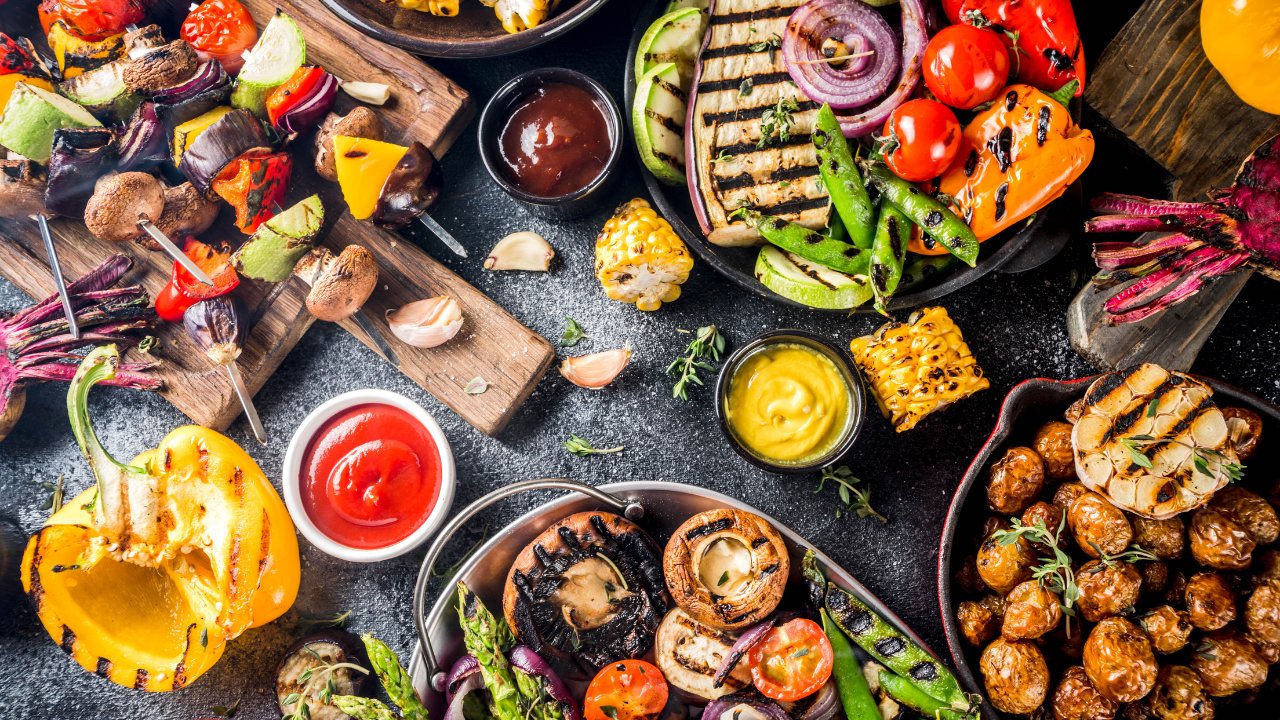Summer is the perfect time for outdoor gatherings, and there’s nothing quite like sounds and smells of food sizzling on the grill to bring family and friends together. But for those of us with mixed-diet families, planning a summer cookout can be a bit more challenging.
Table of Contents
Finding common ground at the dinner table is essential, especially during summer gatherings when we all want to relax and enjoy a simpler dinner routine. As always, I turn to meal ideas and planning strategies that allow me to base my menu around a plant-based core meal with options for everyone. That way, I can satisfy everyone without spending the entire day in the kitchen or at the grill feeling overwhelmed.
Bookmark this post as your go-to guide for practical, delicious grilling tips and ideas that cater to both plant-based and non-vegan family members in the same meal. Whether you’re a seasoned grill master or a novice looking to expand your repertoire, these tips and recipes for grilling for mixed-diet families will help you create a mouthwatering feast that delights everyone at the table.
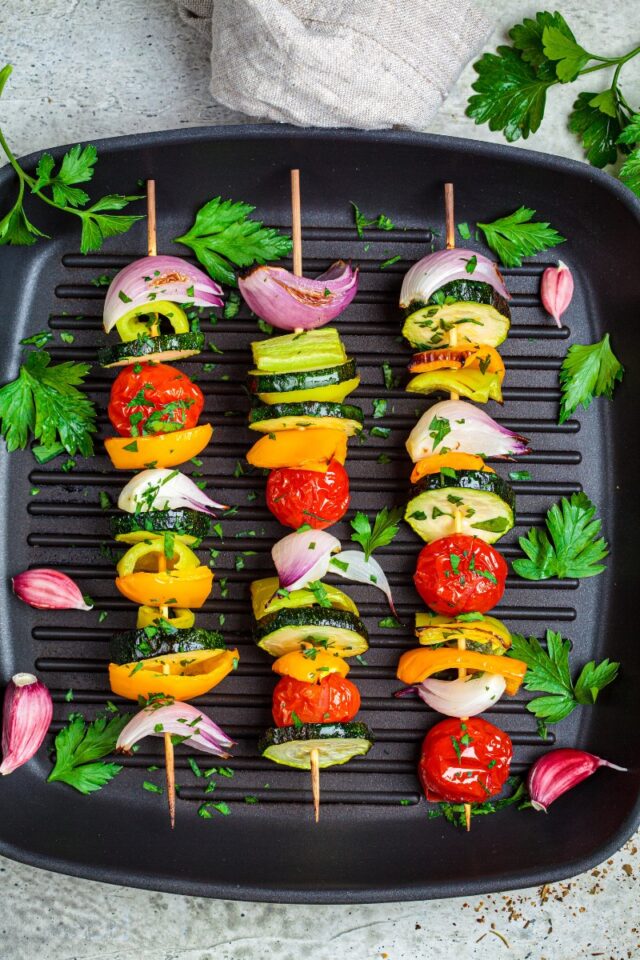
The Benefits of Grilling for Mixed-Diet Families
Grilling is a fantastic way to cater to mixed-diet families, offering a range of benefits for satisfying everyone at the table with one same meal:
Flexibility
One of the greatest advantages of grilling is its flexibility. Whether you’re grilling juicy steaks for the meat lovers or perfectly marinated tofu for the plant-based eaters, the grill allows for easy customization of meals. You can prepare a variety of dishes simultaneously, adjusting the cooking times and temperatures to suit different ingredients. This means you can cater to everyone’s preferences without compromising on flavor or quality. Whether it’s kebabs, burgers or mixed grill night, you can load the grill with veggie and omnivore options at the same time —all cooking harmoniously side by side (figuratively, that is—I always cook the vegan food separately from the non-vegan food).
Social Aspect
Grilling is more than just a cooking method; it’s a social event. There’s something inherently communal about gathering around the grill, chatting with family and friends while the food cooks. It’s an opportunity to bond, share stories, and enjoy each other’s company. By involving everyone in the grilling process, from prepping the ingredients to flipping the food, you foster a sense of togetherness and cooperation.
Health Benefits
Grilling also offers numerous health benefits, especially when it comes to plant-based foods. Grilling vegetables, for instance, enhances their natural flavors without the need for excessive oils or fats. This cooking method helps retain essential nutrients, making your meals both delicious and nutritious. Plant-based proteins like tofu and tempeh can also be grilled to perfection, providing a healthy and satisfying alternative to meat. For non-vegan family members, grilling lean meats and seafood can be a healthier option compared to frying or other cooking methods. The high heat of the grill allows fats to drip away, resulting in lower calorie dishes that are still packed with flavor.
The bottom line? Grilling is a win-win for mixed-diet families. It offers the flexibility to cater to various dietary preferences, promotes social interaction and family bonding, and provides a healthy cooking method that can complement both plant-based and non-vegan options. Summer grilling is no brainer for creating a feast that brings everyone together.
Keys to Success For Grilling For Mixed-Diet Families
Just like any other type of meal prep, success comes with preparation! Below are some key tips to ensure your grilling session goes smoothly and everyone’s dietary needs are met.
Preparing the Grill
Before you even think about placing any food on the grill, it’s crucial to start with a clean slate. A well-maintained grill not only performs better but also ensures that flavors don’t mix between different types of food. Here’s how to prepare your grill for mixed-diet cooking:
- Clean the Grates: Use a grill brush to scrub the grates thoroughly, removing any remnants from previous meals. This prevents any unwanted flavors from transferring to your fresh ingredients.
- Oil the Grates: After cleaning, lightly oil the grates with a high-heat oil like canola or vegetable oil. This helps prevent sticking and makes for easier flipping.
- Preheat the Grill: Preheat your grill for about 10-15 minutes before cooking. This ensures even cooking temperatures and helps burn off any remaining residue.
Zoning the Grill
When grilling for mixed-diet families, it’s essential to create separate zones for plant-based and non-vegan items to avoid cross-contamination. This ensures that everyone can enjoy their meal without any concerns about their dietary restrictions being compromised.
- Designate Zones: Allocate specific areas of the grill for different types of food. For example, keep one side of the grill for plant-based items and the other side for meat and seafood.
- Use Grill Mats or Foil: Consider using grill mats or aluminum foil to create physical barriers between plant-based and non-vegan foods. This not only prevents cross-contamination but also makes cleanup easier.
- Separate Utensils: Use separate tongs, spatulas, and brushes for plant-based and non-vegan items. Labeling or color-coding these utensils can help avoid any mix-ups. (I do this in my kitchen for indoor meal prep too!).
Tools of the Trade
Having the right tools can make your grilling experience more efficient and enjoyable. Here are some essential grilling tools and accessories to ensure a seamless experience:
- Grill Brush: A sturdy grill brush is indispensable for keeping your grates clean and ready for cooking.
- Tongs and Spatulas: Long-handled tongs and spatulas are perfect for flipping and moving food around the grill without burning yourself.
- Meat Thermometer: A reliable meat thermometer ensures your non-vegan items are cooked to the perfect temperature, keeping everyone safe and satisfied.
- Grill Mats and Baskets: Grill mats and baskets are great for cooking smaller items like vegetables and plant-based proteins, preventing them from falling through the grates.
- Basting Brushes: Silicone basting brushes are ideal for applying marinades and sauces evenly without shedding bristles.
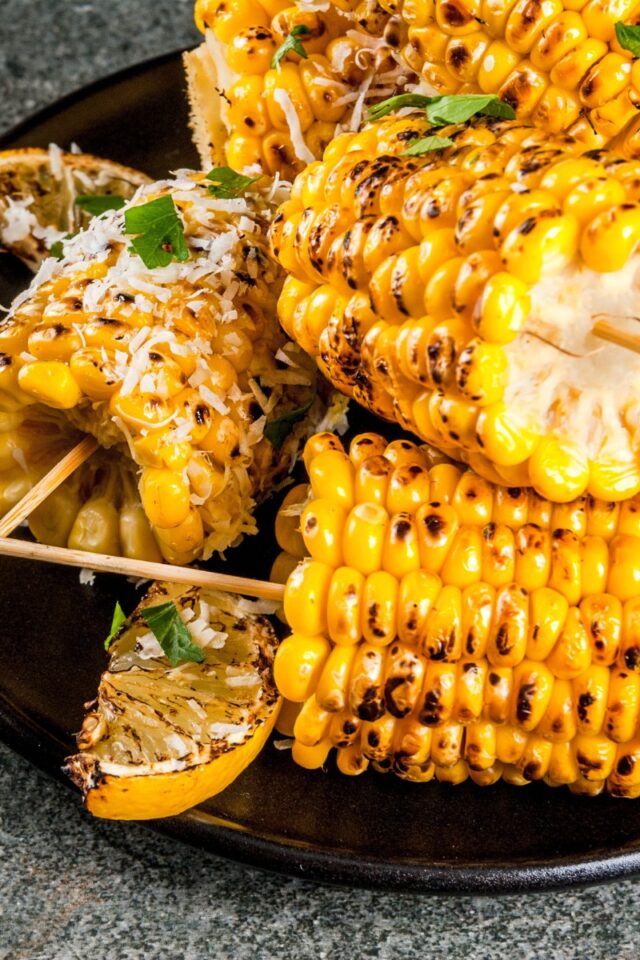
Flavorful Marinades, Rubs, and Inclusive Sides
Marinades and Rubs
One of the secrets to mouthwatering grilled food is a good marinade or rub. They’re the magic touch that elevates your proteins—whether plant-based or non-vegan—from ordinary to extraordinary. Below are a few versatile recipes to fire up your grill.
Versatile Marinade Recipes:
- Classic Herb Marinade:
- Ingredients: Olive oil, lemon juice, minced garlic, fresh thyme, rosemary, salt, and pepper.
- Instructions: Mix all ingredients in a bowl. Add your proteins and vegetables for at least 30 minutes before grilling. This classic blend of herbs and citrus works wonders on everything, imparting a fresh, vibrant flavor.
- Smoky BBQ Marinade:
- Ingredients: Tomato paste, apple cider vinegar, molasses, smoked paprika, garlic powder, onion powder, and a pinch of cayenne.
- Instructions: Combine all ingredients in a bowl. Marinate proteins and vegetables for at least an hour. The smoky and slightly sweet notes of this marinade are perfect for creating that quintessential BBQ taste.
Flavorful Rub Recipes:
- Spicy Cajun Rub:
- Ingredients: Paprika, garlic powder, onion powder, cayenne pepper, dried thyme, oregano, salt, and black pepper.
- Instructions: Mix all spices together. This rub is excellent for adding a spicy kick. Just coat your choice of protein or veggies and grill to perfection.
- Lemon-Pepper Rub:
- Ingredients: Lemon zest, cracked black pepper, sea salt, garlic powder, and dried parsley.
- Instructions: Combine all ingredients. This zesty and peppery rub is fantastic for tofu, chicken, or grilled veggies. It brightens up the flavors and adds a refreshing zing.
Inclusive Sides
Great sides can bring a meal together and ensure everyone at the table is happy. Here are some inclusive side dish ideas that complement both plant-based and non-vegan main courses.
Recipe Ideas:
- Grilled Potatoes:
- Ingredients: Baby potatoes, olive oil, rosemary, salt, and pepper.
- Instructions: Toss the potatoes with olive oil, rosemary, salt, and pepper. Grill on medium heat until they are crispy on the outside and tender on the inside, about 20-25 minutes. These grilled potato wedges are a crowd-pleaser and pair well with any main dish.
- Mixed Salads:
- Ingredients: Mixed greens, cherry tomatoes, cucumbers, red onions, and your favorite dressing.
- Instructions: Combine all ingredients in a large bowl. Top with avocado, nuts, seeds, or croutons. This versatile salad can be customized with various toppings and dressings to suit everyone’s taste.
- Grilled Corn on the Cob:
- Ingredients: Fresh corn on the cob, olive oil, salt, and pepper.
- Instructions: Brush the corn with olive oil and season with salt and pepper. Grill on medium heat for about 10-15 minutes, turning occasionally until the kernels are tender and slightly charred. Simple, yet incredibly delicious!
Unique Fruit Desserts
Grilled fruits add a sweet twist to your barbecue, making for unique desserts that everyone will love.
- Grilled Pineapple:
- Ingredients: Fresh pineapple, honey or agave syrup, lime juice, and cinnamon.
- Instructions: Slice the pineapple into rings or wedges. Brush with a mixture of honey (or agave syrup), lime juice, and a sprinkle of cinnamon. Grill on medium heat for about 3-4 minutes per side until caramelized and slightly charred. This sweet and tangy treat is perfect as a dessert or side dish.
- Grilled Peaches:
- Ingredients: Ripe peaches, olive oil, balsamic glaze, and fresh basil.
- Instructions: Halve the peaches and remove the pits. Brush with olive oil and grill on medium heat for about 3-4 minutes per side until tender and have grill marks. Drizzle with balsamic glaze and garnish with fresh basil before serving. Serve over ice cream and / or sponge cake for a summer worthy dessert.
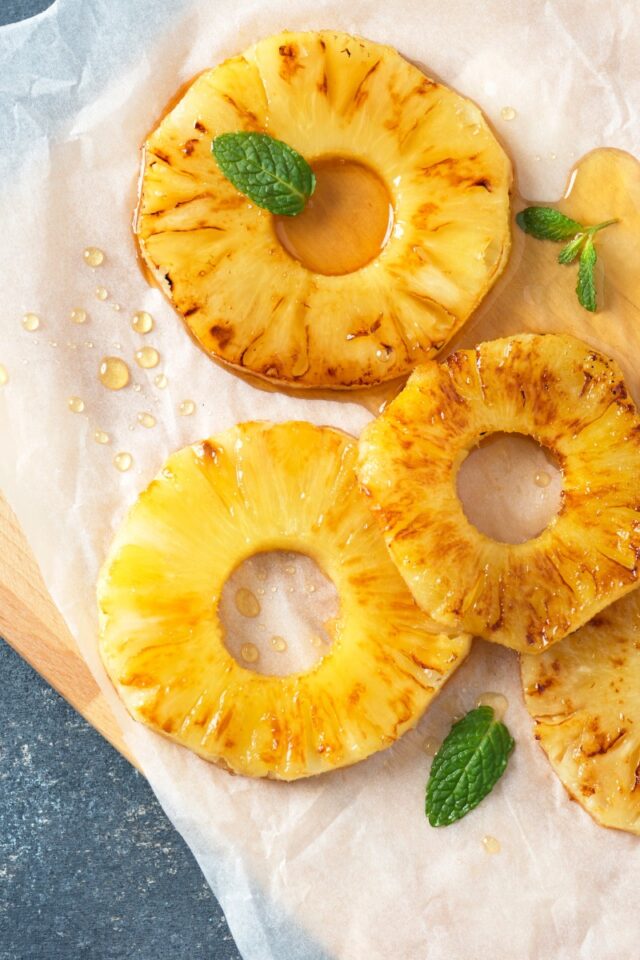
Meal Ideas for Grilling For Mixed-Diet Families
When it comes to feeding my mixed-diet family, I turn to a mixed grill. Just like my indoor dinner menus, I stick to meal ideas that start with a vegan base and adapt or add non-vegan options. Here are some of the go-to grill meals I serve my family.
Mixed Skewers
Customizable skewers are a fantastic way to cater to different tastes and dietary preferences. You can create separate skewers, (even setting up a DIY station for everyone to create their own), ensuring everyone gets exactly what they want.
Recipe for Customizable Skewers:
- Ingredients:
- For Veggie Skewers: Bell peppers, cherry tomatoes, zucchini, red onions, mushrooms, and tofu.
- For Proteins: Tempeh, tofu, chicken, beef or shrimp
- Marinade: Olive oil, lemon juice, minced garlic, dried oregano, salt, and pepper.
- Instructions:
- Cut all ingredients into bite-sized pieces.
- Marinate the veggies and meats separately for at least 30 minutes.
- Thread the veggies and proteins onto skewers, as desired.
- Grill on medium heat, turning occasionally, until the veggies are tender and the meats are cooked through (about 10-15 minutes).
- Serve with a variety of dipping sauces for added flavor.
DIY Grilled Pizzas
Grilled pizzas are a fun and interactive way to cater to mixed-diet families. Set up a pizza grilling station with a variety of plant-based and non-vegan toppings, and let everyone create their own masterpiece. My family loves this so much that we do it year-round!
Setting Up a Pizza Grilling Station:
- Ingredients:
- Pizza dough (store-bought or homemade)
- Tomato sauce, pesto, and olive oil
- Plant-based toppings: vegan cheese, mushrooms, bell peppers, olives, spinach, artichokes, and vegan pepperoni
- Non-vegan toppings: mozzarella, pepperoni, sausage, chicken, and bacon
- Instructions:
- Preheat the grill to medium-high heat.
- Roll out the pizza dough into individual-sized rounds.
- Brush one side with olive oil and place it on the grill, oiled side down. Grill for 2-3 minutes until it starts to bubble and char.
- Flip the dough and add your choice of sauce and toppings.
- Close the grill lid and cook for another 3-5 minutes until the cheese melts and the toppings are heated through.
- Remove from the grill, slice, and enjoy!
Burger Bar
A burger bar is another great way to cater to mixed-diet families. Offer a variety of plant-based and non-vegan options, along with a selection of delicious toppings.
Creating a Burger Bar:
- Ingredients:
- Plant-based burgers: black bean burgers, veggie patties, and Beyond Meat burgers
- Non-vegan burgers: beef patties, turkey burgers, and chicken patties
- Toppings: lettuce, tomato, onion, pickles, avocado, cheese (vegan and regular), bacon, sautéed mushrooms, and various sauces (ketchup, mustard, vegan mayo, BBQ sauce)
- Instructions:
- Grill the burgers according to package or recipe instructions.
- Set up a toppings station where everyone can customize their burgers.
- Serve with buns (regular and gluten-free) and a side of grilled vegetables or potato wedges.
Inclusive BBQ Platters
Creating an inclusive BBQ platter is a wonderful way to showcase a variety of grilled items that cater to all dietary preferences. It’s a feast for the eyes and the taste buds!
Creating an Inclusive BBQ Platter:
- Ingredients:
- Grilled vegetables: asparagus, corn on the cob, bell peppers, and portobello mushrooms
- Plant-based proteins: tofu skewers, tempeh slices, and plant-based sausages
- Non-vegan proteins: grilled chicken, beef steak, and shrimp
- Sides: grilled potatoes, mixed green salad, coleslaw, and garlic bread (with vegan and regular options)
- Instructions:
- Grill all items according to their specific instructions, ensuring you have separate zones for plant-based and non-vegan foods to avoid cross-contamination.
- Arrange everything on a large platter, grouping similar items together.
- Garnish with fresh herbs and lemon wedges for a beautiful presentation.
- Serve with a variety of sauces and dips on the side, making it easy for everyone to find something they love.
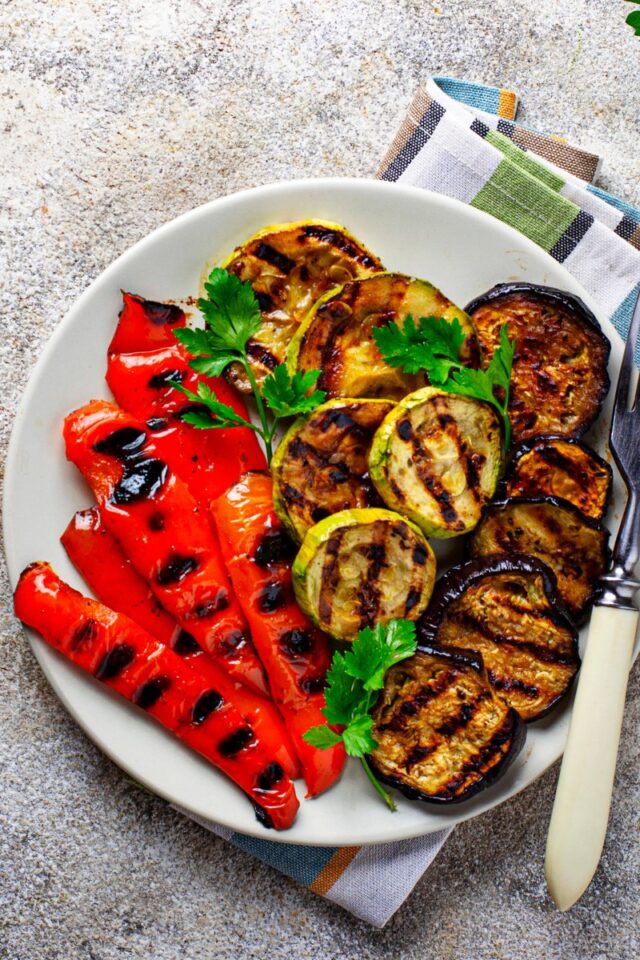
Practical Meal Planning Tips To Grilling For Mixed-Diet Families
Meal planning is a game-changer for busy families and especially with one with mixed dietary needs. During the busy summer months, I take advantage of the time I spend on meal prep to get as much done as possible so I can be outside doing summer fun longer! With a little preparation and organization, you can create a week’s worth of delicious grilling meals that cater to everyone’s dietary needs. Here are some practical tips to help you get started.
Weekly Planning
Planning your meals for the week can save you time, reduce stress, and ensure you have a variety of options that everyone will enjoy. Here’s how to get started:
- Create a Meal Plan: (Check out my full process here.)
- Start by brainstorming a list of meals that everyone in the family enjoys. Include a mix of plant-based and non-vegan options.
- Assign specific meals to each day of the week, considering your family’s schedule and any upcoming events.
- Plan for leftovers by including meals that can be easily reheated or repurposed for lunch the next day.
- Balance Your Menu:
- Ensure that your meal plan includes a variety of proteins, vegetables, and grains to keep everyone satisfied and nourished.
- Incorporate different cuisines and flavors to keep things interesting and prevent meal fatigue.
- Prep Ahead:
- Take some time at the beginning of the week to prep ingredients for multiple meals. Chop vegetables, marinate proteins, and prepare any sauces or dressings in advance.
- Store prepped ingredients in labeled containers in the fridge, making it easy to grab what you need when it’s time to cook.
Shopping List
A well-organized shopping list can make your grocery trips more efficient and help ensure you don’t forget any essential ingredients. Here’s how to create a categorized shopping list:
- Divide Your List into Categories:
- Group items by section of the grocery store: produce, pantry staples, proteins, dairy alternatives, and miscellaneous items. Pro tip: List the items in the layout of the store so you move through your list as you move through the store.
- Include specific quantities to avoid overbuying or running out of key ingredients.
- Audit Your Staples:
- Make sure to list pantry staples that you use frequently, such as olive oil, spices, grains, and canned goods.
- Check your inventory before heading to the store to avoid purchasing duplicates.
Batch Cooking
Batch cooking is a fantastic way to save time and ensure you have plenty of options on hand for quick, easy meals throughout the week. Here are some tips for successful batch cooking:
- Grill in Batches:
- Choose a day when you have some extra time to dedicate to grilling. Cook multiple proteins and vegetables in larger quantities.
- Store grilled items in airtight containers in the fridge or freezer. This way, you can mix and match ingredients to create different meals throughout the week.
- Portion and Label:
- Divide cooked items into individual portions, making it easy to grab and reheat what you need.
- Label each container with the contents and date, so you know what you have and how long it will stay fresh.
- Repurpose Leftovers:
- Get creative with leftovers by turning grilled veggies into a stir-fry, using grilled chicken for salads or wraps, and incorporating grilled fruits into desserts or breakfasts.
- Plan meals that can be easily transformed with a few additional ingredients, reducing food waste and keeping your menu exciting.
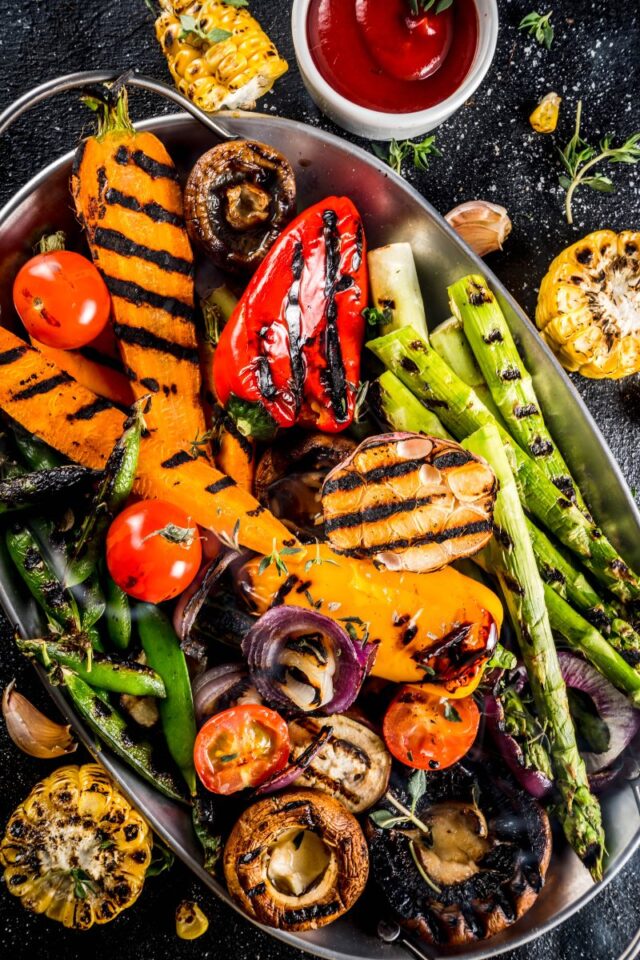
Other Grill Recipes You May Enjoy
As we step into summer, grilling is a fantastic option for feeding mixed-diet families with one meal, but offers benefits throughout the year depending on the weather and resources available to you. With its flexibility, allowing you to customize meals to suit everyone’s dietary needs, and social aspect to meal preparation, it creates a perfect opportunity for family connection over food — one of my favorite things!
I hope these recipes and tips are helpful. Experiment with the mixed skewers, DIY grilled pizzas, burger bars, and inclusive BBQ platters. Embrace the meal planning strategies to make your summer dinners stress-free and enjoyable. Whether you’re a seasoned griller or a newbie, I hope the ideas bring joy, inclusivity, and deliciousness to your family meals.
Happy grilling and enjoy the summer with your loved ones!

